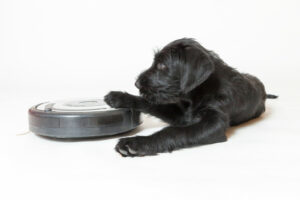Barks Blog
Training Tips: My Puppy Is a Scaredy Cat
By Sally Bradbury

The world can be a scary place for a puppy sometimes, so it is important that we don’t put him into situations that he cannot cope with. For example, if your puppy is scared of large chubby bearded men in red coats, then you can just keep him away from the chimney on Christmas Eve. However, we also need to help him to not be scared of everyday things like the vacuum cleaner, the dog behind the fence up the road, visitors to the house…all the things he is likely encounter regularly.
Constant exposure to something that produces a fearful response will ensure that the puppy becomes increasingly fearful and there is the risk that it can become a real fear or phobia. Let’s take the vacuum cleaner as an example. There will be two stages to this, as vacuum cleaners both LOOK and SOUND scary. We can start by letting the puppy see the ‘scary monster’ in the room and giving him a food treat every time he looks at it or investigates it. When he is completely relaxed, then we might push it or pull it a couple of inches across the carpet while the puppy watches and enjoys a treat with each movement.
Counterconditioning
Before we plug in and turn on the vacuum cleaner, the puppy needs to be as far away as possible, preferably in another room. You’ll need a helper to turn on a stationary vacuum cleaner while you feed the pup a succession of treats. Over several sessions you can bring the vacuum cleaner closer, gradually, making sure he remains under threshold. He’ll not only get used to the noise and sight of the vacuum cleaner, as well as seeing it moving, he will also start to associate it with the food and thus positive feelings instead of negative ones.
Counterconditioning, i.e. pairing something positive with a low level of something scary is not about changing behavior, but about how the dog feels, i.e. his emotional response. Learn to recognize when your pup is scared and allow him to retreat and watch from a distance.
In the words of Jacobs (2017): “Keep the dog feeling safe. Be prepared to make anything that already scares, or might scare, the dog a predictor of something fabulous. Use food. Fabulous food. Train the dog to do exactly what you’d like them to do when in the presence of something that does or might scare them. When we use high rates of positive reinforcement to train appropriate behaviors we don’t need to worry about them making bad choices.”
References
Jacobs, D. (2017). High Risk Activities. Available at:
https://www.fearfuldogs.com/high-risk-activities
This article was first published in BARKS from the Guild, September 2019, p.33. Available at: https://issuu.com/petprofessionalguild/docs/bftg_sept_2019_online_edition_final_opt/33
About the Author
Sally Bradbury has worked with dogs all her adult life, from RSPCA kennel maid in her teens to founding and running her own very successful dog training business for 20 years. She was also a founding member of the APDT (United Kingdom). Her passion is helping and supporting new puppy owners raise their puppy to avoid the many pitfalls that results in so many youngsters being handed into rescues in their first year. She is now retired and living in Wales and has recently published children’s book, Jack and Billy: Puppy Tales, featuring two puppies who experience vastly different journeys in their new homes (https://www.jackandbillypuppytales.com).
